A Pilot Review: Comparing Inpatient and Outpatient Care for Anorexia
VerifiedAdded on 2023/06/10
|72
|20170
|66
Literature Review
AI Summary
This literature review examines the effectiveness of inpatient and outpatient treatment programs for anorexia nervosa. It investigates health outcomes associated with both approaches, focusing on improvements in BMI, weight, and reduction in anxiety, depression, and concerns about body shape. The review analyzes existing evidence to determine which treatment modality is more effective in managing anorexia nervosa, considering factors like structured treatment sessions, insurance coverage, and the feasibility of maintaining other commitments. While both inpatient and outpatient programs demonstrate success in treating anorexia nervosa, the review highlights the potential advantages of outpatient and community programs, particularly in the long-term management of the condition.
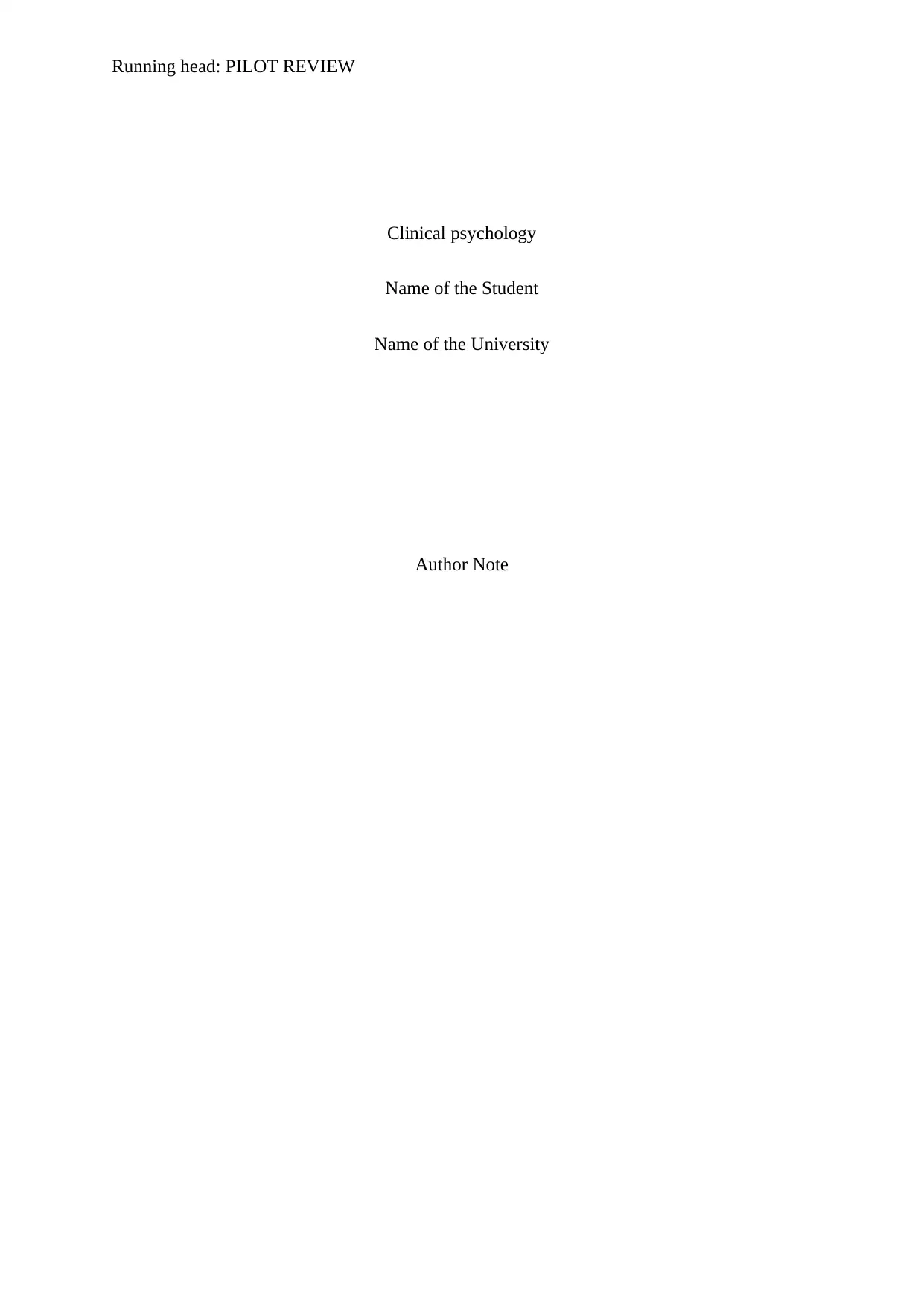
Running head: PILOT REVIEW
Clinical psychology
Name of the Student
Name of the University
Author Note
Clinical psychology
Name of the Student
Name of the University
Author Note
Paraphrase This Document
Need a fresh take? Get an instant paraphrase of this document with our AI Paraphraser
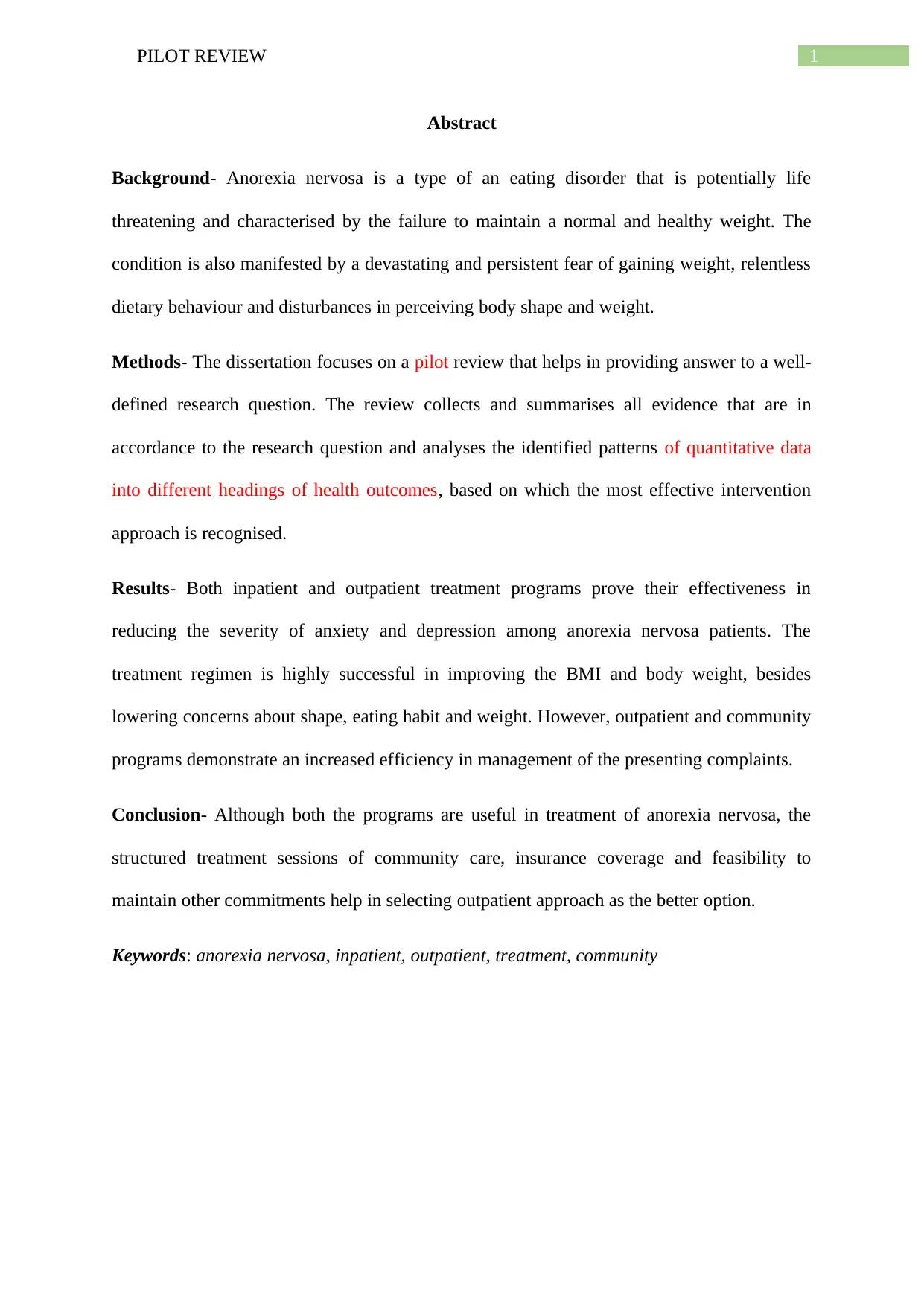
1PILOT REVIEW
Abstract
Background- Anorexia nervosa is a type of an eating disorder that is potentially life
threatening and characterised by the failure to maintain a normal and healthy weight. The
condition is also manifested by a devastating and persistent fear of gaining weight, relentless
dietary behaviour and disturbances in perceiving body shape and weight.
Methods- The dissertation focuses on a pilot review that helps in providing answer to a well-
defined research question. The review collects and summarises all evidence that are in
accordance to the research question and analyses the identified patterns of quantitative data
into different headings of health outcomes, based on which the most effective intervention
approach is recognised.
Results- Both inpatient and outpatient treatment programs prove their effectiveness in
reducing the severity of anxiety and depression among anorexia nervosa patients. The
treatment regimen is highly successful in improving the BMI and body weight, besides
lowering concerns about shape, eating habit and weight. However, outpatient and community
programs demonstrate an increased efficiency in management of the presenting complaints.
Conclusion- Although both the programs are useful in treatment of anorexia nervosa, the
structured treatment sessions of community care, insurance coverage and feasibility to
maintain other commitments help in selecting outpatient approach as the better option.
Keywords: anorexia nervosa, inpatient, outpatient, treatment, community
Abstract
Background- Anorexia nervosa is a type of an eating disorder that is potentially life
threatening and characterised by the failure to maintain a normal and healthy weight. The
condition is also manifested by a devastating and persistent fear of gaining weight, relentless
dietary behaviour and disturbances in perceiving body shape and weight.
Methods- The dissertation focuses on a pilot review that helps in providing answer to a well-
defined research question. The review collects and summarises all evidence that are in
accordance to the research question and analyses the identified patterns of quantitative data
into different headings of health outcomes, based on which the most effective intervention
approach is recognised.
Results- Both inpatient and outpatient treatment programs prove their effectiveness in
reducing the severity of anxiety and depression among anorexia nervosa patients. The
treatment regimen is highly successful in improving the BMI and body weight, besides
lowering concerns about shape, eating habit and weight. However, outpatient and community
programs demonstrate an increased efficiency in management of the presenting complaints.
Conclusion- Although both the programs are useful in treatment of anorexia nervosa, the
structured treatment sessions of community care, insurance coverage and feasibility to
maintain other commitments help in selecting outpatient approach as the better option.
Keywords: anorexia nervosa, inpatient, outpatient, treatment, community
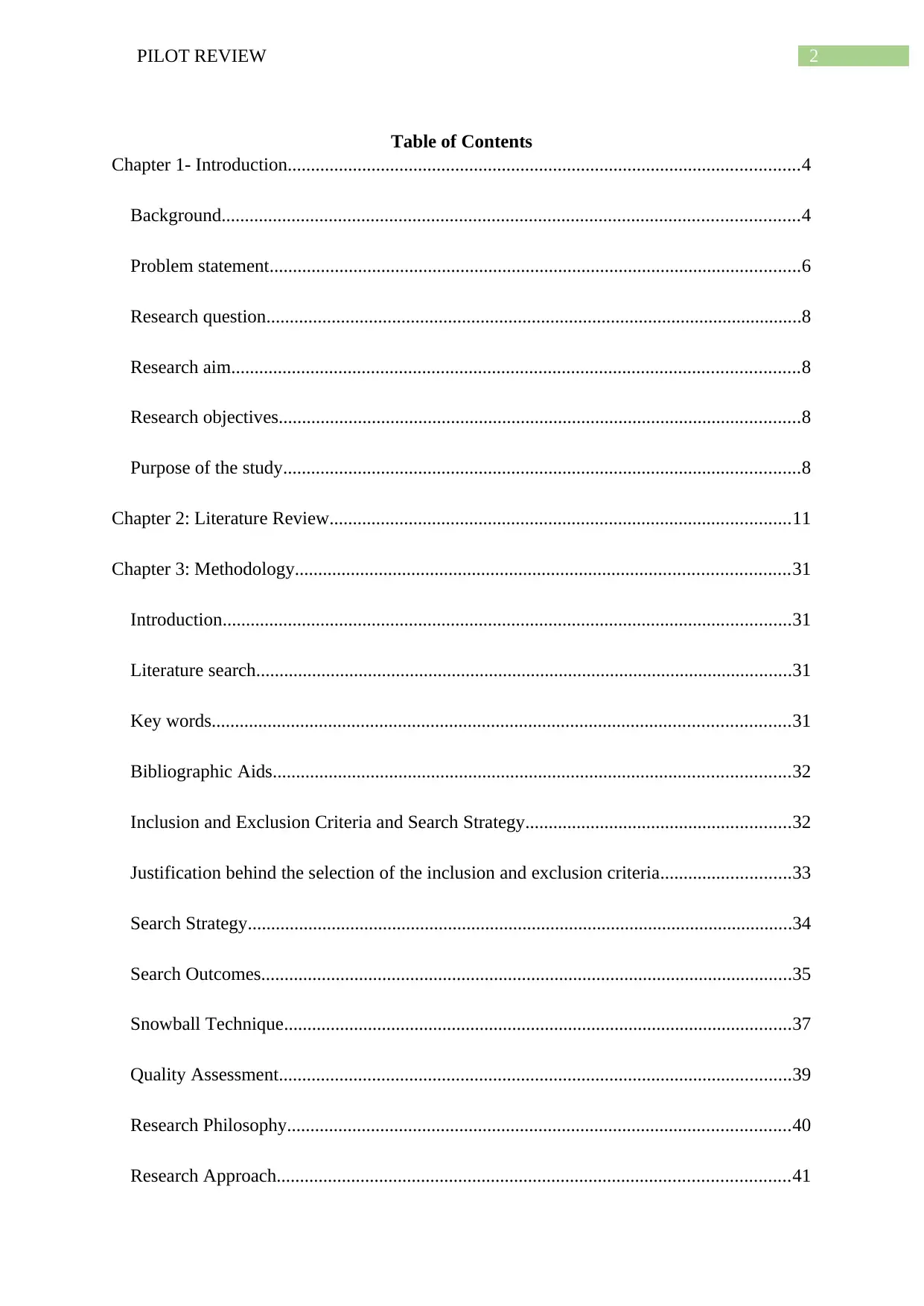
2PILOT REVIEW
Table of Contents
Chapter 1- Introduction..............................................................................................................4
Background............................................................................................................................4
Problem statement..................................................................................................................6
Research question...................................................................................................................8
Research aim..........................................................................................................................8
Research objectives................................................................................................................8
Purpose of the study...............................................................................................................8
Chapter 2: Literature Review...................................................................................................11
Chapter 3: Methodology..........................................................................................................31
Introduction..........................................................................................................................31
Literature search...................................................................................................................31
Key words............................................................................................................................31
Bibliographic Aids...............................................................................................................32
Inclusion and Exclusion Criteria and Search Strategy.........................................................32
Justification behind the selection of the inclusion and exclusion criteria............................33
Search Strategy.....................................................................................................................34
Search Outcomes..................................................................................................................35
Snowball Technique.............................................................................................................37
Quality Assessment..............................................................................................................39
Research Philosophy............................................................................................................40
Research Approach..............................................................................................................41
Table of Contents
Chapter 1- Introduction..............................................................................................................4
Background............................................................................................................................4
Problem statement..................................................................................................................6
Research question...................................................................................................................8
Research aim..........................................................................................................................8
Research objectives................................................................................................................8
Purpose of the study...............................................................................................................8
Chapter 2: Literature Review...................................................................................................11
Chapter 3: Methodology..........................................................................................................31
Introduction..........................................................................................................................31
Literature search...................................................................................................................31
Key words............................................................................................................................31
Bibliographic Aids...............................................................................................................32
Inclusion and Exclusion Criteria and Search Strategy.........................................................32
Justification behind the selection of the inclusion and exclusion criteria............................33
Search Strategy.....................................................................................................................34
Search Outcomes..................................................................................................................35
Snowball Technique.............................................................................................................37
Quality Assessment..............................................................................................................39
Research Philosophy............................................................................................................40
Research Approach..............................................................................................................41
⊘ This is a preview!⊘
Do you want full access?
Subscribe today to unlock all pages.

Trusted by 1+ million students worldwide
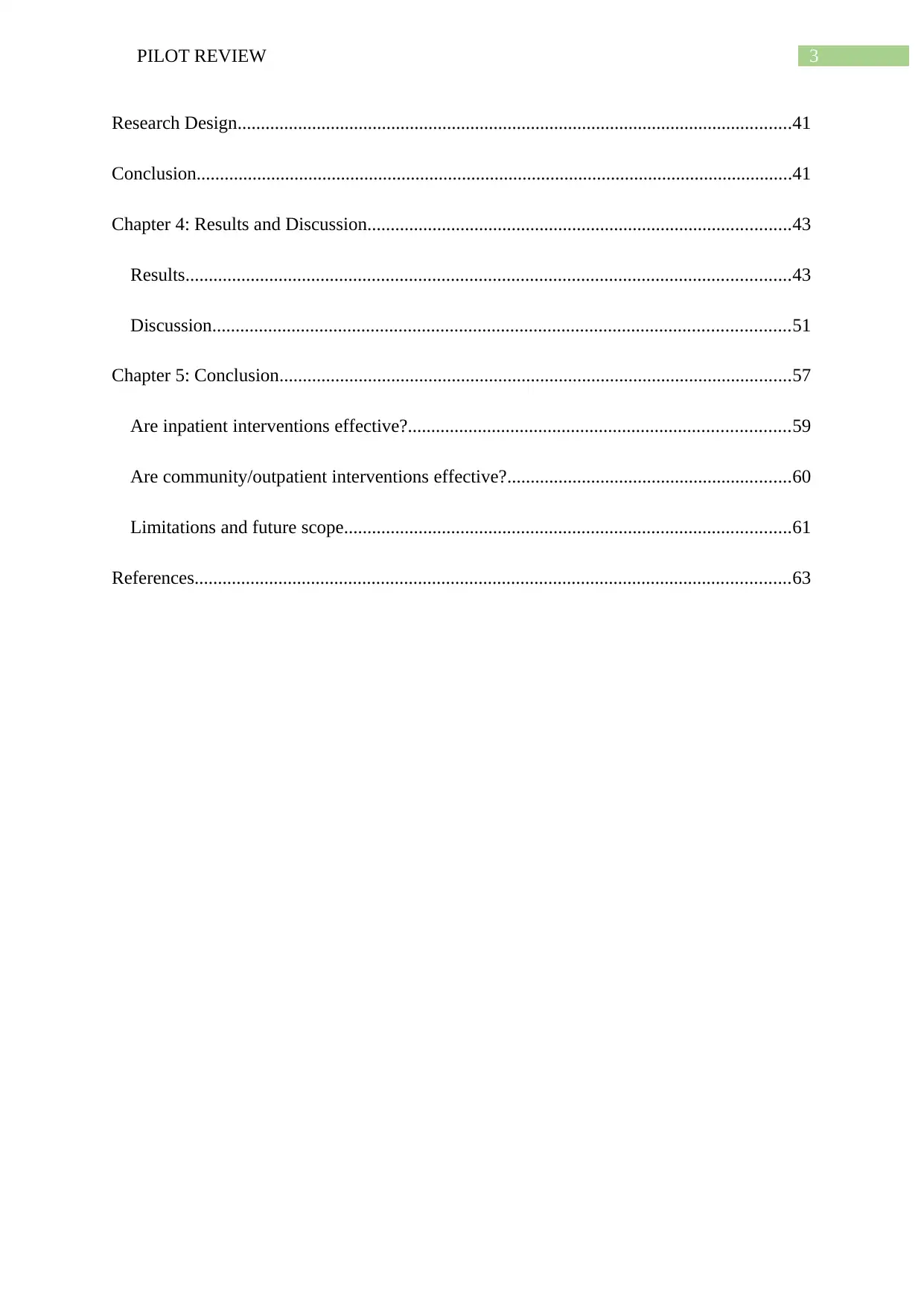
3PILOT REVIEW
Research Design.......................................................................................................................41
Conclusion................................................................................................................................41
Chapter 4: Results and Discussion...........................................................................................43
Results..................................................................................................................................43
Discussion............................................................................................................................51
Chapter 5: Conclusion..............................................................................................................57
Are inpatient interventions effective?..................................................................................59
Are community/outpatient interventions effective?.............................................................60
Limitations and future scope................................................................................................61
References................................................................................................................................63
Research Design.......................................................................................................................41
Conclusion................................................................................................................................41
Chapter 4: Results and Discussion...........................................................................................43
Results..................................................................................................................................43
Discussion............................................................................................................................51
Chapter 5: Conclusion..............................................................................................................57
Are inpatient interventions effective?..................................................................................59
Are community/outpatient interventions effective?.............................................................60
Limitations and future scope................................................................................................61
References................................................................................................................................63
Paraphrase This Document
Need a fresh take? Get an instant paraphrase of this document with our AI Paraphraser
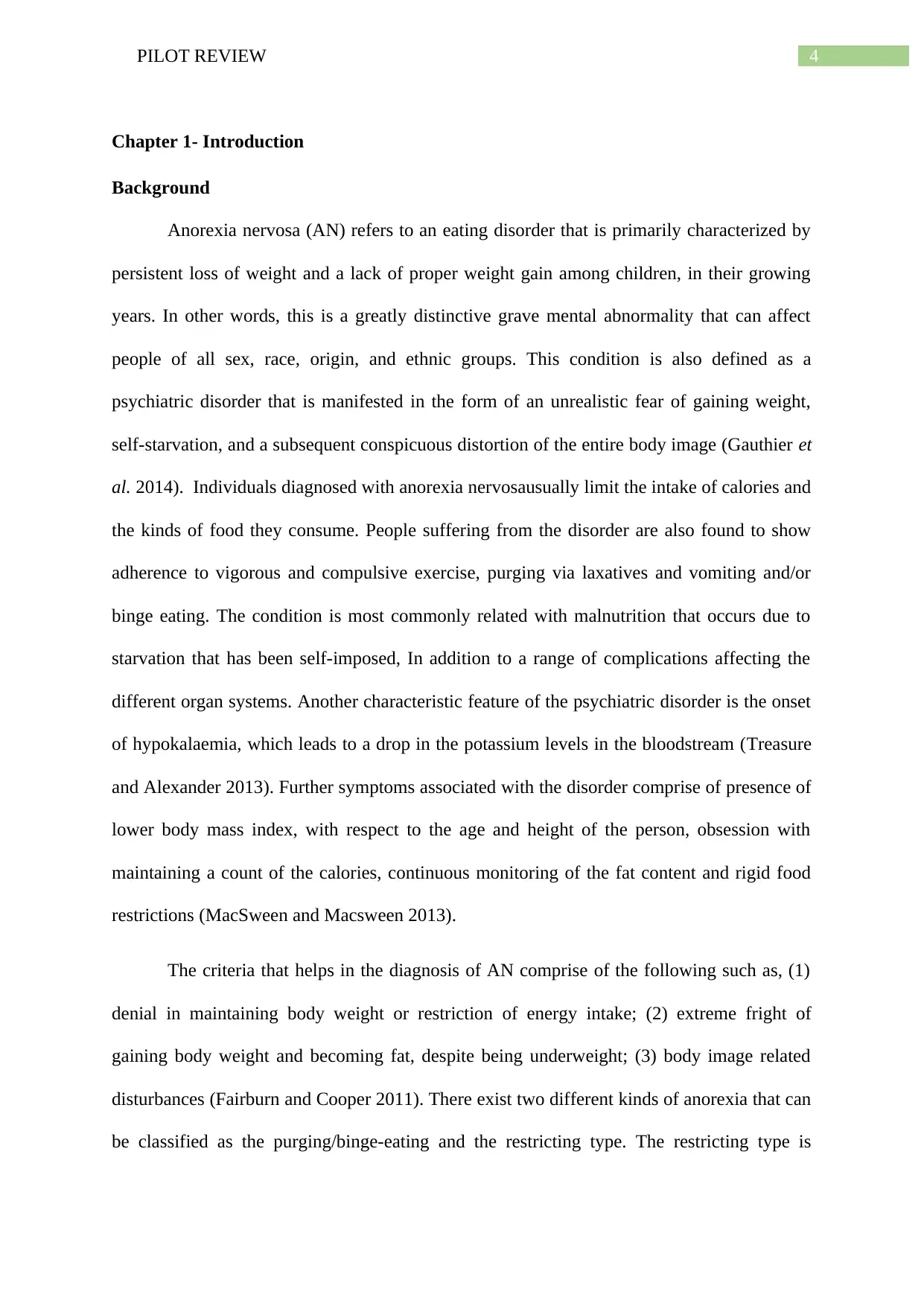
4PILOT REVIEW
Chapter 1- Introduction
Background
Anorexia nervosa (AN) refers to an eating disorder that is primarily characterized by
persistent loss of weight and a lack of proper weight gain among children, in their growing
years. In other words, this is a greatly distinctive grave mental abnormality that can affect
people of all sex, race, origin, and ethnic groups. This condition is also defined as a
psychiatric disorder that is manifested in the form of an unrealistic fear of gaining weight,
self-starvation, and a subsequent conspicuous distortion of the entire body image (Gauthier et
al. 2014). Individuals diagnosed with anorexia nervosausually limit the intake of calories and
the kinds of food they consume. People suffering from the disorder are also found to show
adherence to vigorous and compulsive exercise, purging via laxatives and vomiting and/or
binge eating. The condition is most commonly related with malnutrition that occurs due to
starvation that has been self-imposed, In addition to a range of complications affecting the
different organ systems. Another characteristic feature of the psychiatric disorder is the onset
of hypokalaemia, which leads to a drop in the potassium levels in the bloodstream (Treasure
and Alexander 2013). Further symptoms associated with the disorder comprise of presence of
lower body mass index, with respect to the age and height of the person, obsession with
maintaining a count of the calories, continuous monitoring of the fat content and rigid food
restrictions (MacSween and Macsween 2013).
The criteria that helps in the diagnosis of AN comprise of the following such as, (1)
denial in maintaining body weight or restriction of energy intake; (2) extreme fright of
gaining body weight and becoming fat, despite being underweight; (3) body image related
disturbances (Fairburn and Cooper 2011). There exist two different kinds of anorexia that can
be classified as the purging/binge-eating and the restricting type. The restricting type is
Chapter 1- Introduction
Background
Anorexia nervosa (AN) refers to an eating disorder that is primarily characterized by
persistent loss of weight and a lack of proper weight gain among children, in their growing
years. In other words, this is a greatly distinctive grave mental abnormality that can affect
people of all sex, race, origin, and ethnic groups. This condition is also defined as a
psychiatric disorder that is manifested in the form of an unrealistic fear of gaining weight,
self-starvation, and a subsequent conspicuous distortion of the entire body image (Gauthier et
al. 2014). Individuals diagnosed with anorexia nervosausually limit the intake of calories and
the kinds of food they consume. People suffering from the disorder are also found to show
adherence to vigorous and compulsive exercise, purging via laxatives and vomiting and/or
binge eating. The condition is most commonly related with malnutrition that occurs due to
starvation that has been self-imposed, In addition to a range of complications affecting the
different organ systems. Another characteristic feature of the psychiatric disorder is the onset
of hypokalaemia, which leads to a drop in the potassium levels in the bloodstream (Treasure
and Alexander 2013). Further symptoms associated with the disorder comprise of presence of
lower body mass index, with respect to the age and height of the person, obsession with
maintaining a count of the calories, continuous monitoring of the fat content and rigid food
restrictions (MacSween and Macsween 2013).
The criteria that helps in the diagnosis of AN comprise of the following such as, (1)
denial in maintaining body weight or restriction of energy intake; (2) extreme fright of
gaining body weight and becoming fat, despite being underweight; (3) body image related
disturbances (Fairburn and Cooper 2011). There exist two different kinds of anorexia that can
be classified as the purging/binge-eating and the restricting type. The restricting type is

5PILOT REVIEW
generally diagnosed when the affected person does not engage in any form of binge eating or
purging, but limits his/her food intake in place. Conversely, the purging/binge-eating type is
identified when the affected individual has had events of eliminating and bingeing between
periods of limiting food intake. The disorder commonly occurs in young women and
adolescent girls, in addition to individuals approaching puberty and women reaching
menopause (Darcy et al. 2012). The disorder encompasses a specific psychopathology
characterised by a persistent fear of flabbiness and fatness of the body contour, thereby
making the patients enforce a threshold related to establishment of low weight.
Interoception is imperative in the maintenance of homeostasis in the body and also
helps in understanding the feelings(Racine and Wildes 2015). AN has time and again been
correlated with a range of disturbances that interfere with interoception. Person diagnosed
with AN often concentrate more the misleading perceptions related to their physique, due to
the fright of appearing obese or overweight. Apart from their external appearance, these
people have also been found to report presence of abnormalities in their bodily functions such
as, inarticulate state of mind that perceives fullness. This is a direct manifestation of
miscommunication between the human brain and the body (Kaye et al. 2013). Furthermore,
individuals with AN also experience atypically strong cardio-respiratory perception,
predominantly of their breath, which is found to be utmost dominant before the consumption
of their meals. AN affected person also report their incompetence in distinguishing between
their feelings from the bodily sensations, a condition commonly termed as alexithymia.
Besides metacognition, AN patients have also provided evidences of facing trouble
with their social cognition that generally encompasses interpretation of the emotions of other
people (Strigoet al. 2013). AN alsohas a tendency to run in families, thereby suggesting the
role of certain genetic components in its incidence and prevalence (Rikaniet al. 2013). In
other words, the condition is heritable. Twin studies have been conducted that have
generally diagnosed when the affected person does not engage in any form of binge eating or
purging, but limits his/her food intake in place. Conversely, the purging/binge-eating type is
identified when the affected individual has had events of eliminating and bingeing between
periods of limiting food intake. The disorder commonly occurs in young women and
adolescent girls, in addition to individuals approaching puberty and women reaching
menopause (Darcy et al. 2012). The disorder encompasses a specific psychopathology
characterised by a persistent fear of flabbiness and fatness of the body contour, thereby
making the patients enforce a threshold related to establishment of low weight.
Interoception is imperative in the maintenance of homeostasis in the body and also
helps in understanding the feelings(Racine and Wildes 2015). AN has time and again been
correlated with a range of disturbances that interfere with interoception. Person diagnosed
with AN often concentrate more the misleading perceptions related to their physique, due to
the fright of appearing obese or overweight. Apart from their external appearance, these
people have also been found to report presence of abnormalities in their bodily functions such
as, inarticulate state of mind that perceives fullness. This is a direct manifestation of
miscommunication between the human brain and the body (Kaye et al. 2013). Furthermore,
individuals with AN also experience atypically strong cardio-respiratory perception,
predominantly of their breath, which is found to be utmost dominant before the consumption
of their meals. AN affected person also report their incompetence in distinguishing between
their feelings from the bodily sensations, a condition commonly termed as alexithymia.
Besides metacognition, AN patients have also provided evidences of facing trouble
with their social cognition that generally encompasses interpretation of the emotions of other
people (Strigoet al. 2013). AN alsohas a tendency to run in families, thereby suggesting the
role of certain genetic components in its incidence and prevalence (Rikaniet al. 2013). In
other words, the condition is heritable. Twin studies have been conducted that have
⊘ This is a preview!⊘
Do you want full access?
Subscribe today to unlock all pages.

Trusted by 1+ million students worldwide
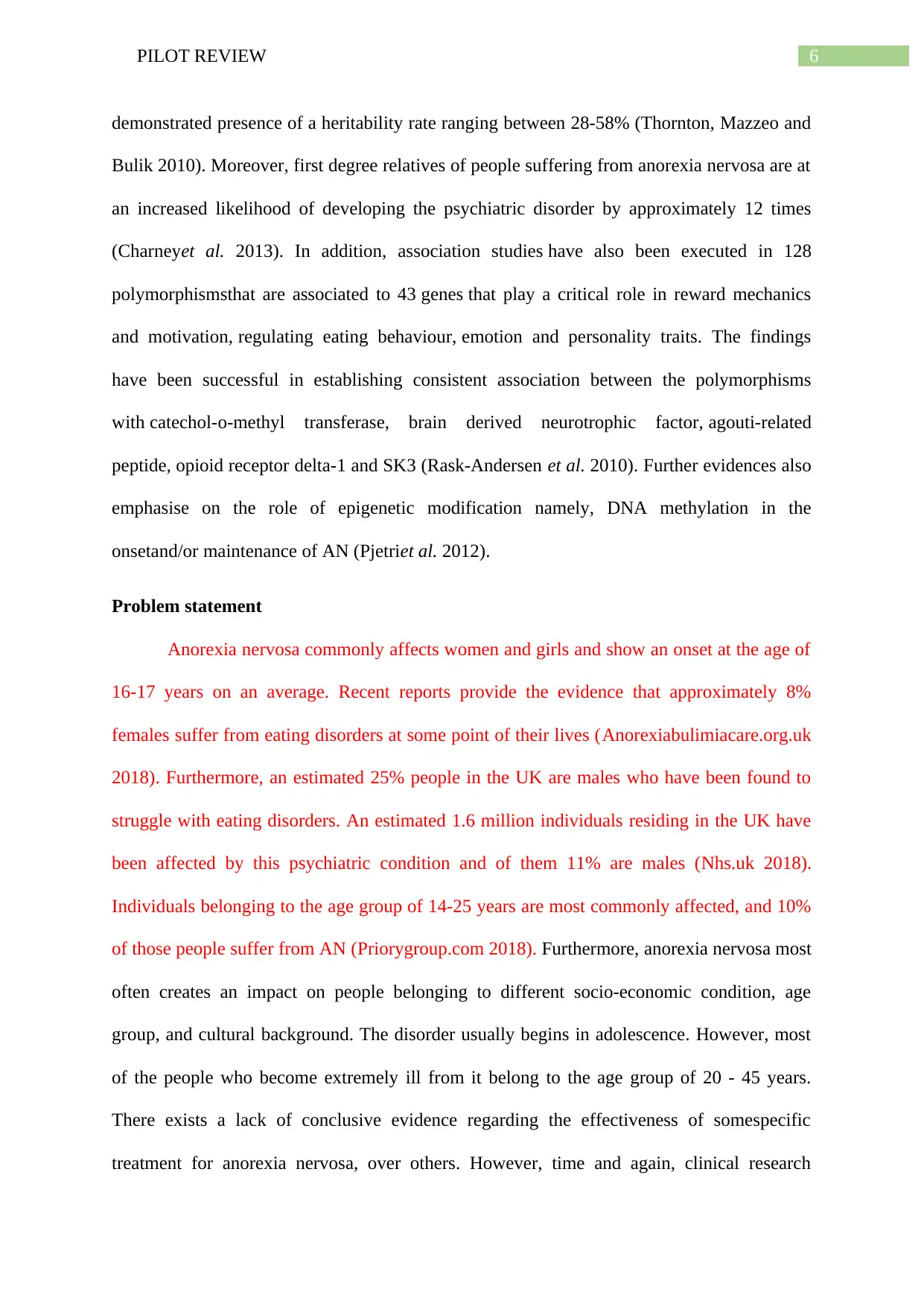
6PILOT REVIEW
demonstrated presence of a heritability rate ranging between 28-58% (Thornton, Mazzeo and
Bulik 2010). Moreover, first degree relatives of people suffering from anorexia nervosa are at
an increased likelihood of developing the psychiatric disorder by approximately 12 times
(Charneyet al. 2013). In addition, association studies have also been executed in 128
polymorphismsthat are associated to 43 genes that play a critical role in reward mechanics
and motivation, regulating eating behaviour, emotion and personality traits. The findings
have been successful in establishing consistent association between the polymorphisms
with catechol-o-methyl transferase, brain derived neurotrophic factor, agouti-related
peptide, opioid receptor delta-1 and SK3 (Rask-Andersen et al. 2010). Further evidences also
emphasise on the role of epigenetic modification namely, DNA methylation in the
onsetand/or maintenance of AN (Pjetriet al. 2012).
Problem statement
Anorexia nervosa commonly affects women and girls and show an onset at the age of
16-17 years on an average. Recent reports provide the evidence that approximately 8%
females suffer from eating disorders at some point of their lives (Anorexiabulimiacare.org.uk
2018). Furthermore, an estimated 25% people in the UK are males who have been found to
struggle with eating disorders. An estimated 1.6 million individuals residing in the UK have
been affected by this psychiatric condition and of them 11% are males (Nhs.uk 2018).
Individuals belonging to the age group of 14-25 years are most commonly affected, and 10%
of those people suffer from AN (Priorygroup.com 2018). Furthermore, anorexia nervosa most
often creates an impact on people belonging to different socio-economic condition, age
group, and cultural background. The disorder usually begins in adolescence. However, most
of the people who become extremely ill from it belong to the age group of 20 - 45 years.
There exists a lack of conclusive evidence regarding the effectiveness of somespecific
treatment for anorexia nervosa, over others. However, time and again, clinical research
demonstrated presence of a heritability rate ranging between 28-58% (Thornton, Mazzeo and
Bulik 2010). Moreover, first degree relatives of people suffering from anorexia nervosa are at
an increased likelihood of developing the psychiatric disorder by approximately 12 times
(Charneyet al. 2013). In addition, association studies have also been executed in 128
polymorphismsthat are associated to 43 genes that play a critical role in reward mechanics
and motivation, regulating eating behaviour, emotion and personality traits. The findings
have been successful in establishing consistent association between the polymorphisms
with catechol-o-methyl transferase, brain derived neurotrophic factor, agouti-related
peptide, opioid receptor delta-1 and SK3 (Rask-Andersen et al. 2010). Further evidences also
emphasise on the role of epigenetic modification namely, DNA methylation in the
onsetand/or maintenance of AN (Pjetriet al. 2012).
Problem statement
Anorexia nervosa commonly affects women and girls and show an onset at the age of
16-17 years on an average. Recent reports provide the evidence that approximately 8%
females suffer from eating disorders at some point of their lives (Anorexiabulimiacare.org.uk
2018). Furthermore, an estimated 25% people in the UK are males who have been found to
struggle with eating disorders. An estimated 1.6 million individuals residing in the UK have
been affected by this psychiatric condition and of them 11% are males (Nhs.uk 2018).
Individuals belonging to the age group of 14-25 years are most commonly affected, and 10%
of those people suffer from AN (Priorygroup.com 2018). Furthermore, anorexia nervosa most
often creates an impact on people belonging to different socio-economic condition, age
group, and cultural background. The disorder usually begins in adolescence. However, most
of the people who become extremely ill from it belong to the age group of 20 - 45 years.
There exists a lack of conclusive evidence regarding the effectiveness of somespecific
treatment for anorexia nervosa, over others. However, time and again, clinical research
Paraphrase This Document
Need a fresh take? Get an instant paraphrase of this document with our AI Paraphraser
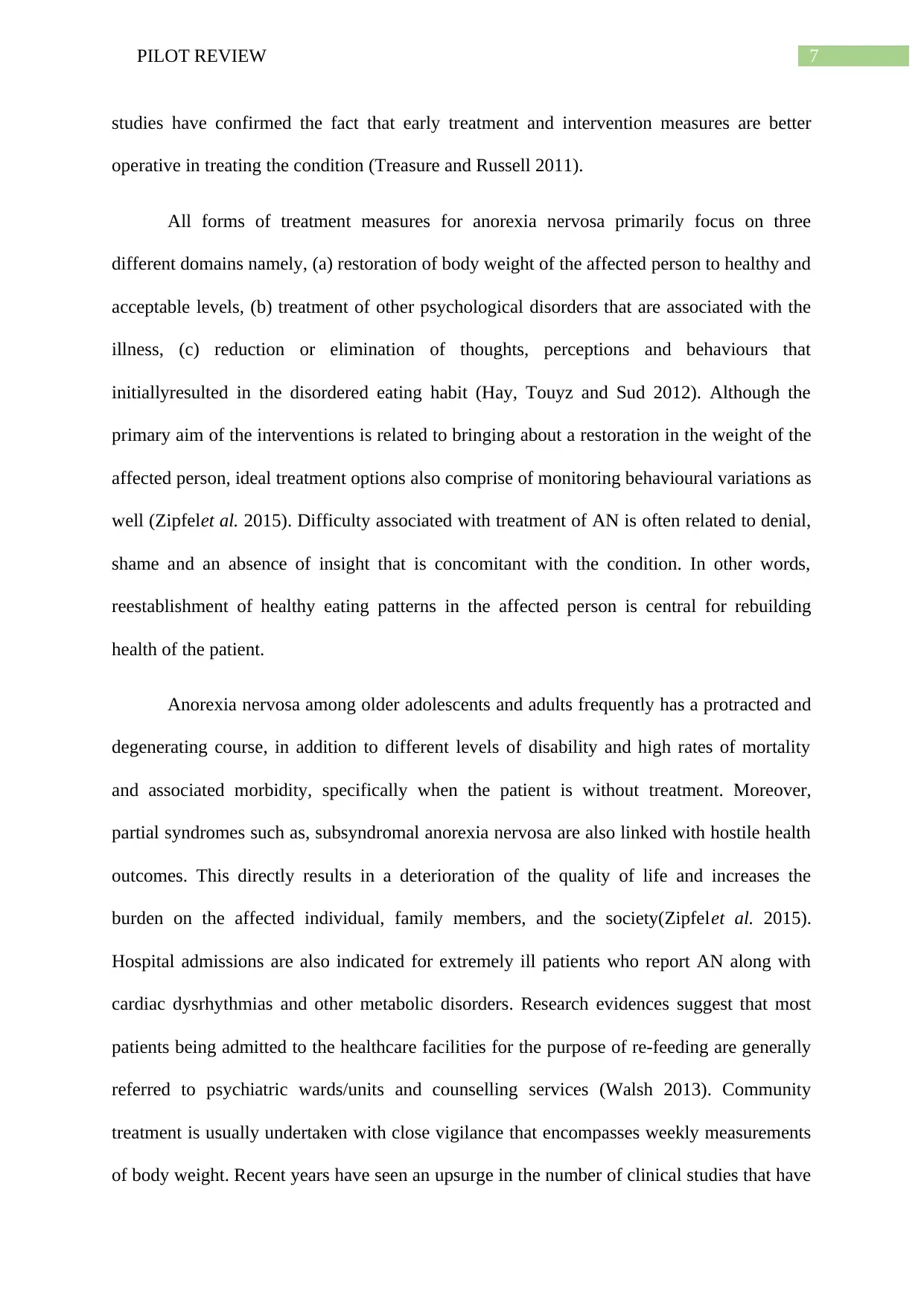
7PILOT REVIEW
studies have confirmed the fact that early treatment and intervention measures are better
operative in treating the condition (Treasure and Russell 2011).
All forms of treatment measures for anorexia nervosa primarily focus on three
different domains namely, (a) restoration of body weight of the affected person to healthy and
acceptable levels, (b) treatment of other psychological disorders that are associated with the
illness, (c) reduction or elimination of thoughts, perceptions and behaviours that
initiallyresulted in the disordered eating habit (Hay, Touyz and Sud 2012). Although the
primary aim of the interventions is related to bringing about a restoration in the weight of the
affected person, ideal treatment options also comprise of monitoring behavioural variations as
well (Zipfelet al. 2015). Difficulty associated with treatment of AN is often related to denial,
shame and an absence of insight that is concomitant with the condition. In other words,
reestablishment of healthy eating patterns in the affected person is central for rebuilding
health of the patient.
Anorexia nervosa among older adolescents and adults frequently has a protracted and
degenerating course, in addition to different levels of disability and high rates of mortality
and associated morbidity, specifically when the patient is without treatment. Moreover,
partial syndromes such as, subsyndromal anorexia nervosa are also linked with hostile health
outcomes. This directly results in a deterioration of the quality of life and increases the
burden on the affected individual, family members, and the society(Zipfelet al. 2015).
Hospital admissions are also indicated for extremely ill patients who report AN along with
cardiac dysrhythmias and other metabolic disorders. Research evidences suggest that most
patients being admitted to the healthcare facilities for the purpose of re-feeding are generally
referred to psychiatric wards/units and counselling services (Walsh 2013). Community
treatment is usually undertaken with close vigilance that encompasses weekly measurements
of body weight. Recent years have seen an upsurge in the number of clinical studies that have
studies have confirmed the fact that early treatment and intervention measures are better
operative in treating the condition (Treasure and Russell 2011).
All forms of treatment measures for anorexia nervosa primarily focus on three
different domains namely, (a) restoration of body weight of the affected person to healthy and
acceptable levels, (b) treatment of other psychological disorders that are associated with the
illness, (c) reduction or elimination of thoughts, perceptions and behaviours that
initiallyresulted in the disordered eating habit (Hay, Touyz and Sud 2012). Although the
primary aim of the interventions is related to bringing about a restoration in the weight of the
affected person, ideal treatment options also comprise of monitoring behavioural variations as
well (Zipfelet al. 2015). Difficulty associated with treatment of AN is often related to denial,
shame and an absence of insight that is concomitant with the condition. In other words,
reestablishment of healthy eating patterns in the affected person is central for rebuilding
health of the patient.
Anorexia nervosa among older adolescents and adults frequently has a protracted and
degenerating course, in addition to different levels of disability and high rates of mortality
and associated morbidity, specifically when the patient is without treatment. Moreover,
partial syndromes such as, subsyndromal anorexia nervosa are also linked with hostile health
outcomes. This directly results in a deterioration of the quality of life and increases the
burden on the affected individual, family members, and the society(Zipfelet al. 2015).
Hospital admissions are also indicated for extremely ill patients who report AN along with
cardiac dysrhythmias and other metabolic disorders. Research evidences suggest that most
patients being admitted to the healthcare facilities for the purpose of re-feeding are generally
referred to psychiatric wards/units and counselling services (Walsh 2013). Community
treatment is usually undertaken with close vigilance that encompasses weekly measurements
of body weight. Recent years have seen an upsurge in the number of clinical studies that have
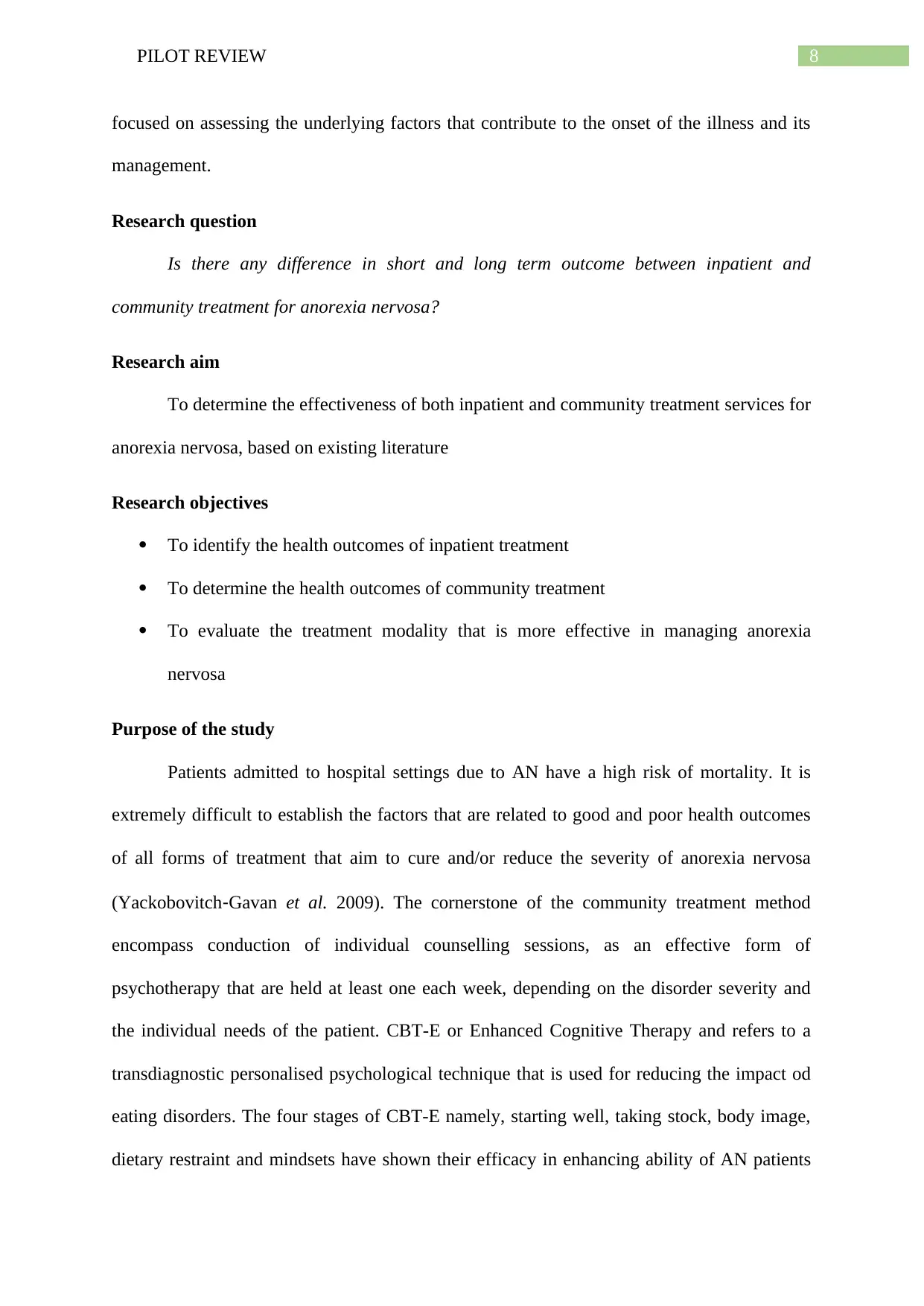
8PILOT REVIEW
focused on assessing the underlying factors that contribute to the onset of the illness and its
management.
Research question
Is there any difference in short and long term outcome between inpatient and
community treatment for anorexia nervosa?
Research aim
To determine the effectiveness of both inpatient and community treatment services for
anorexia nervosa, based on existing literature
Research objectives
To identify the health outcomes of inpatient treatment
To determine the health outcomes of community treatment
To evaluate the treatment modality that is more effective in managing anorexia
nervosa
Purpose of the study
Patients admitted to hospital settings due to AN have a high risk of mortality. It is
extremely difficult to establish the factors that are related to good and poor health outcomes
of all forms of treatment that aim to cure and/or reduce the severity of anorexia nervosa
(Yackobovitch‐Gavan et al. 2009). The cornerstone of the community treatment method
encompass conduction of individual counselling sessions, as an effective form of
psychotherapy that are held at least one each week, depending on the disorder severity and
the individual needs of the patient. CBT-E or Enhanced Cognitive Therapy and refers to a
transdiagnostic personalised psychological technique that is used for reducing the impact od
eating disorders. The four stages of CBT-E namely, starting well, taking stock, body image,
dietary restraint and mindsets have shown their efficacy in enhancing ability of AN patients
focused on assessing the underlying factors that contribute to the onset of the illness and its
management.
Research question
Is there any difference in short and long term outcome between inpatient and
community treatment for anorexia nervosa?
Research aim
To determine the effectiveness of both inpatient and community treatment services for
anorexia nervosa, based on existing literature
Research objectives
To identify the health outcomes of inpatient treatment
To determine the health outcomes of community treatment
To evaluate the treatment modality that is more effective in managing anorexia
nervosa
Purpose of the study
Patients admitted to hospital settings due to AN have a high risk of mortality. It is
extremely difficult to establish the factors that are related to good and poor health outcomes
of all forms of treatment that aim to cure and/or reduce the severity of anorexia nervosa
(Yackobovitch‐Gavan et al. 2009). The cornerstone of the community treatment method
encompass conduction of individual counselling sessions, as an effective form of
psychotherapy that are held at least one each week, depending on the disorder severity and
the individual needs of the patient. CBT-E or Enhanced Cognitive Therapy and refers to a
transdiagnostic personalised psychological technique that is used for reducing the impact od
eating disorders. The four stages of CBT-E namely, starting well, taking stock, body image,
dietary restraint and mindsets have shown their efficacy in enhancing ability of AN patients
⊘ This is a preview!⊘
Do you want full access?
Subscribe today to unlock all pages.

Trusted by 1+ million students worldwide
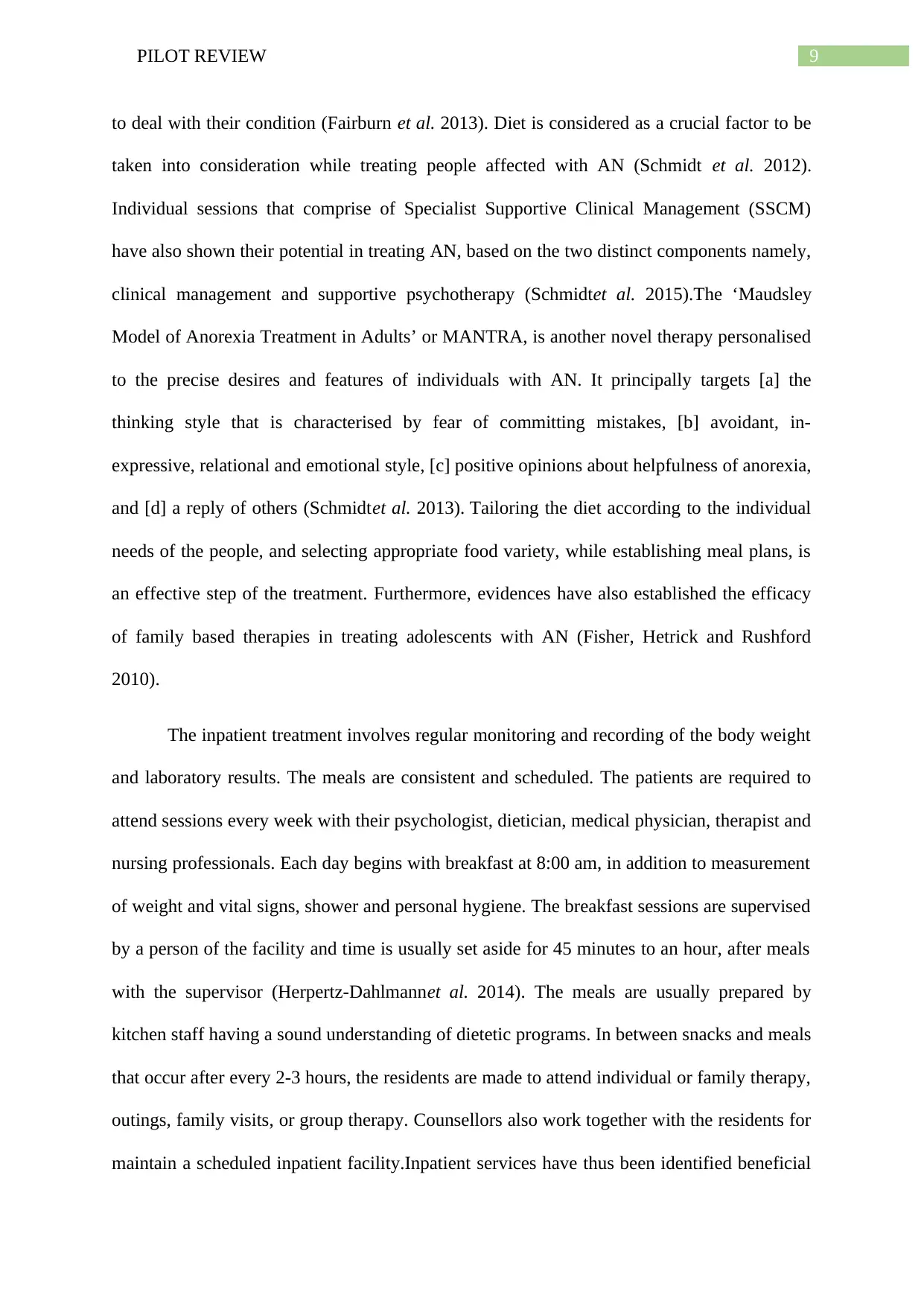
9PILOT REVIEW
to deal with their condition (Fairburn et al. 2013). Diet is considered as a crucial factor to be
taken into consideration while treating people affected with AN (Schmidt et al. 2012).
Individual sessions that comprise of Specialist Supportive Clinical Management (SSCM)
have also shown their potential in treating AN, based on the two distinct components namely,
clinical management and supportive psychotherapy (Schmidtet al. 2015).The ‘Maudsley
Model of Anorexia Treatment in Adults’ or MANTRA, is another novel therapy personalised
to the precise desires and features of individuals with AN. It principally targets [a] the
thinking style that is characterised by fear of committing mistakes, [b] avoidant, in-
expressive, relational and emotional style, [c] positive opinions about helpfulness of anorexia,
and [d] a reply of others (Schmidtet al. 2013). Tailoring the diet according to the individual
needs of the people, and selecting appropriate food variety, while establishing meal plans, is
an effective step of the treatment. Furthermore, evidences have also established the efficacy
of family based therapies in treating adolescents with AN (Fisher, Hetrick and Rushford
2010).
The inpatient treatment involves regular monitoring and recording of the body weight
and laboratory results. The meals are consistent and scheduled. The patients are required to
attend sessions every week with their psychologist, dietician, medical physician, therapist and
nursing professionals. Each day begins with breakfast at 8:00 am, in addition to measurement
of weight and vital signs, shower and personal hygiene. The breakfast sessions are supervised
by a person of the facility and time is usually set aside for 45 minutes to an hour, after meals
with the supervisor (Herpertz-Dahlmannet al. 2014). The meals are usually prepared by
kitchen staff having a sound understanding of dietetic programs. In between snacks and meals
that occur after every 2-3 hours, the residents are made to attend individual or family therapy,
outings, family visits, or group therapy. Counsellors also work together with the residents for
maintain a scheduled inpatient facility.Inpatient services have thus been identified beneficial
to deal with their condition (Fairburn et al. 2013). Diet is considered as a crucial factor to be
taken into consideration while treating people affected with AN (Schmidt et al. 2012).
Individual sessions that comprise of Specialist Supportive Clinical Management (SSCM)
have also shown their potential in treating AN, based on the two distinct components namely,
clinical management and supportive psychotherapy (Schmidtet al. 2015).The ‘Maudsley
Model of Anorexia Treatment in Adults’ or MANTRA, is another novel therapy personalised
to the precise desires and features of individuals with AN. It principally targets [a] the
thinking style that is characterised by fear of committing mistakes, [b] avoidant, in-
expressive, relational and emotional style, [c] positive opinions about helpfulness of anorexia,
and [d] a reply of others (Schmidtet al. 2013). Tailoring the diet according to the individual
needs of the people, and selecting appropriate food variety, while establishing meal plans, is
an effective step of the treatment. Furthermore, evidences have also established the efficacy
of family based therapies in treating adolescents with AN (Fisher, Hetrick and Rushford
2010).
The inpatient treatment involves regular monitoring and recording of the body weight
and laboratory results. The meals are consistent and scheduled. The patients are required to
attend sessions every week with their psychologist, dietician, medical physician, therapist and
nursing professionals. Each day begins with breakfast at 8:00 am, in addition to measurement
of weight and vital signs, shower and personal hygiene. The breakfast sessions are supervised
by a person of the facility and time is usually set aside for 45 minutes to an hour, after meals
with the supervisor (Herpertz-Dahlmannet al. 2014). The meals are usually prepared by
kitchen staff having a sound understanding of dietetic programs. In between snacks and meals
that occur after every 2-3 hours, the residents are made to attend individual or family therapy,
outings, family visits, or group therapy. Counsellors also work together with the residents for
maintain a scheduled inpatient facility.Inpatient services have thus been identified beneficial
Paraphrase This Document
Need a fresh take? Get an instant paraphrase of this document with our AI Paraphraser
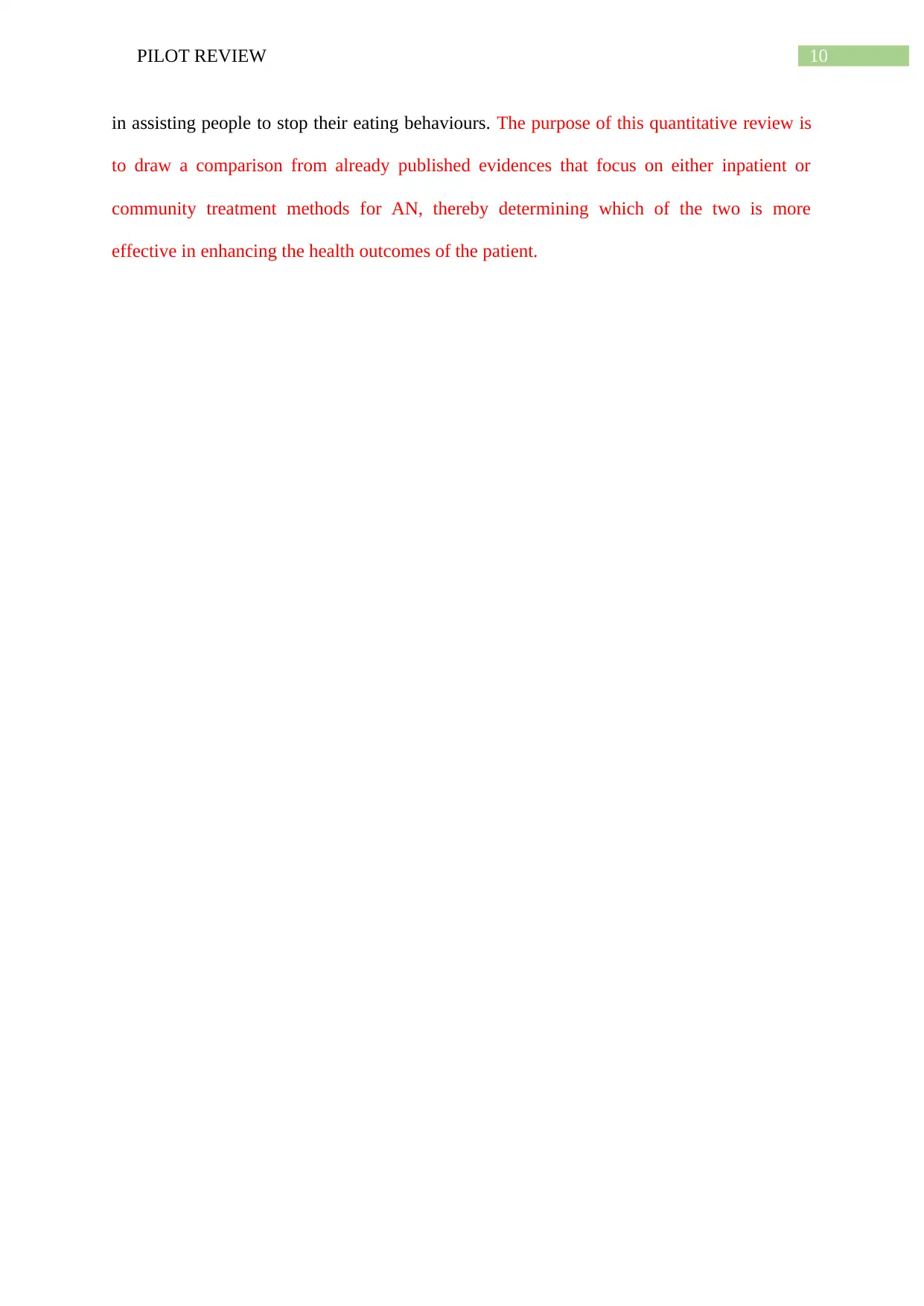
10PILOT REVIEW
in assisting people to stop their eating behaviours. The purpose of this quantitative review is
to draw a comparison from already published evidences that focus on either inpatient or
community treatment methods for AN, thereby determining which of the two is more
effective in enhancing the health outcomes of the patient.
in assisting people to stop their eating behaviours. The purpose of this quantitative review is
to draw a comparison from already published evidences that focus on either inpatient or
community treatment methods for AN, thereby determining which of the two is more
effective in enhancing the health outcomes of the patient.
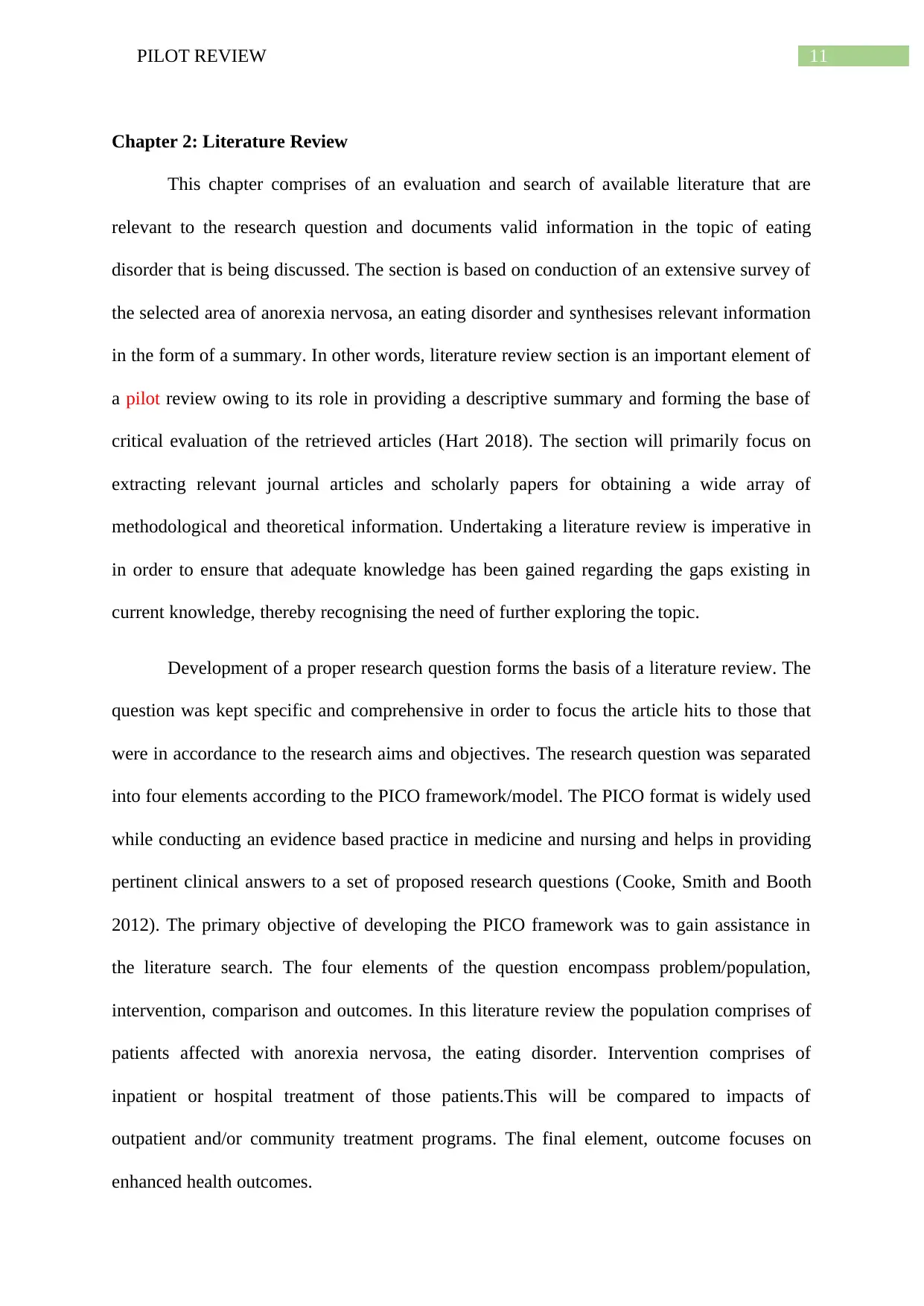
11PILOT REVIEW
Chapter 2: Literature Review
This chapter comprises of an evaluation and search of available literature that are
relevant to the research question and documents valid information in the topic of eating
disorder that is being discussed. The section is based on conduction of an extensive survey of
the selected area of anorexia nervosa, an eating disorder and synthesises relevant information
in the form of a summary. In other words, literature review section is an important element of
a pilot review owing to its role in providing a descriptive summary and forming the base of
critical evaluation of the retrieved articles (Hart 2018). The section will primarily focus on
extracting relevant journal articles and scholarly papers for obtaining a wide array of
methodological and theoretical information. Undertaking a literature review is imperative in
in order to ensure that adequate knowledge has been gained regarding the gaps existing in
current knowledge, thereby recognising the need of further exploring the topic.
Development of a proper research question forms the basis of a literature review. The
question was kept specific and comprehensive in order to focus the article hits to those that
were in accordance to the research aims and objectives. The research question was separated
into four elements according to the PICO framework/model. The PICO format is widely used
while conducting an evidence based practice in medicine and nursing and helps in providing
pertinent clinical answers to a set of proposed research questions (Cooke, Smith and Booth
2012). The primary objective of developing the PICO framework was to gain assistance in
the literature search. The four elements of the question encompass problem/population,
intervention, comparison and outcomes. In this literature review the population comprises of
patients affected with anorexia nervosa, the eating disorder. Intervention comprises of
inpatient or hospital treatment of those patients.This will be compared to impacts of
outpatient and/or community treatment programs. The final element, outcome focuses on
enhanced health outcomes.
Chapter 2: Literature Review
This chapter comprises of an evaluation and search of available literature that are
relevant to the research question and documents valid information in the topic of eating
disorder that is being discussed. The section is based on conduction of an extensive survey of
the selected area of anorexia nervosa, an eating disorder and synthesises relevant information
in the form of a summary. In other words, literature review section is an important element of
a pilot review owing to its role in providing a descriptive summary and forming the base of
critical evaluation of the retrieved articles (Hart 2018). The section will primarily focus on
extracting relevant journal articles and scholarly papers for obtaining a wide array of
methodological and theoretical information. Undertaking a literature review is imperative in
in order to ensure that adequate knowledge has been gained regarding the gaps existing in
current knowledge, thereby recognising the need of further exploring the topic.
Development of a proper research question forms the basis of a literature review. The
question was kept specific and comprehensive in order to focus the article hits to those that
were in accordance to the research aims and objectives. The research question was separated
into four elements according to the PICO framework/model. The PICO format is widely used
while conducting an evidence based practice in medicine and nursing and helps in providing
pertinent clinical answers to a set of proposed research questions (Cooke, Smith and Booth
2012). The primary objective of developing the PICO framework was to gain assistance in
the literature search. The four elements of the question encompass problem/population,
intervention, comparison and outcomes. In this literature review the population comprises of
patients affected with anorexia nervosa, the eating disorder. Intervention comprises of
inpatient or hospital treatment of those patients.This will be compared to impacts of
outpatient and/or community treatment programs. The final element, outcome focuses on
enhanced health outcomes.
⊘ This is a preview!⊘
Do you want full access?
Subscribe today to unlock all pages.

Trusted by 1+ million students worldwide
1 out of 72
Your All-in-One AI-Powered Toolkit for Academic Success.
+13062052269
info@desklib.com
Available 24*7 on WhatsApp / Email
![[object Object]](/_next/static/media/star-bottom.7253800d.svg)
Unlock your academic potential
Copyright © 2020–2026 A2Z Services. All Rights Reserved. Developed and managed by ZUCOL.


